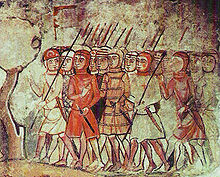Almogàvers
Almogàvers , derived from the Arabic al-Mugavari for scout, was the name of a force of Catalan soldiers who became famous in the Reconquista and were widely used as mercenaries in Italy and the Levant in the 13th and 14th centuries .
history
The Almogàvars originally came from the Pyrenees and were later recruited mainly in Aragon and Catalonia . They were border residents and foot soldiers without armor, clad in furs, wore shoes with punched holes ( abarcas ), and carried the same weapons as the Roman legionaries : two heavy javelins ( Catalan Atzagaia , Spanish Azagaya , the Roman pilum ), a short sword and one Sign.
They were mercenaries and served the king, the nobility, the church or the cities. When Peter III. of Aragon went to war against Charles I of Anjou for possession of Naples and Sicily after the Sicilian Vespers of March 30, 1282 , the Almogàvars formed the most effective part of his army. Their discipline and ferocity, the strength with which they hurled their spears, made them formidable opponents to the heavy cavalry of the Angevin armies.
In 1302 the war in southern Italy ended with the Peace of Caltabellotta . The Almogàvars now followed Roger de Flor , an outcast Templar , joined the Catalan Company and served with the Byzantine Emperor Andronikos II to fight the Turks like Condottieri .
Their campaign in Asia Minor in 1303 and 1304 was a series of victories, but their greed and violence made them unacceptable to the Christian population. When Roger de Flor was murdered by his Greek client, they turned against the emperor and plundered the area around Constantinople from Gallipoli .
In 1310 she invited Walter V of Brienne to the Duchy of Athens . Walter was defeated in March 1311 in the Battle of Kephissus (or Orchomenus) in Boeotia and killed with his knights. Thereupon the Almogàvers seized the rule, raffled the women and the property of the French among themselves and appointed a prince from Rosselló as duke.
The establishment of the Catalan Duchy of Athens was the culmination of the Almogàvers' deeds. The name died out in the 16th century , but was used again for a short time during the civil war at the time of King Ferdinand VII of Spain as a nickname for one of the warring factions.
Others
The comic Héctor, adalid de los almogávares with texts by Fernando M. Sesén and drawings by Chiqui de la Fuente refers to the history of the Almogávers.
literature
- Paul N. Morris: "We have met Devils!" The Almogavars of James I and Peter III of Catalonia-Aragon , Anistoriton 4 (2000) Hellas On Line ( Memento from October 10, 2003 in the Internet Archive )
